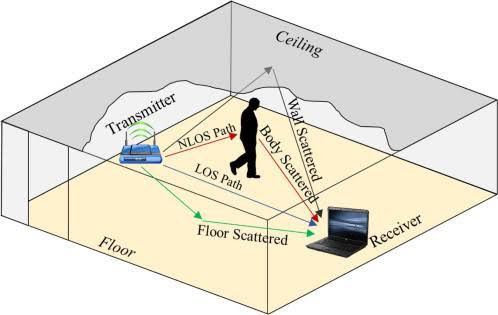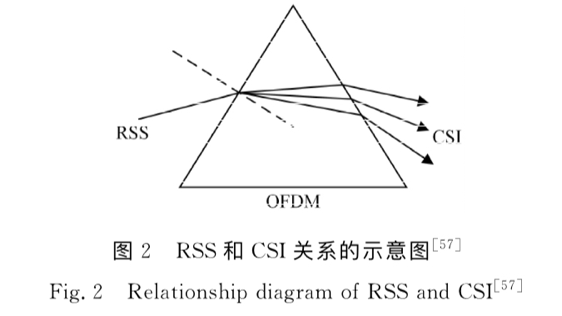1. Introduction
As a widely adopted wireless communication technology, Wi-Fi offers several advantages such as affordability, easy accessibility, non-contact nature, and passive perception, making it an ideal choice for wireless sensing and recognition. Innovative technologies like Identify Tech and Wi-Fi Sensing have emerged to leverage Wi-Fi signals in various ways. Identify technology, also known as Wi-Fi sensing or Wi-Fi tracking, utilizes signals emitted by Wi-Fi devices to identify and track the presence and movements of individuals within a specific area. These identification systems can detect individuals and estimate their locations without the need for additional hardware or wearable devices. They achieve this by analyzing Wi-Fi signal characteristics such as signal intensity, time of flight, and other relevant parameters. In the context of the new generation, identification technology based on Wi-Fi information has gained significant attention. It offers promising applications in diverse fields. For example, in smart homes, Wi-Fi-based identification technology can enable personalized services and seamless automation by recognizing and adapting to occupants' preferences and behaviors. In the realm of intelligent security systems, Wi-Fi sensing can enhance intrusion detection and access control by detecting and identifying authorized users based on their unique Wi-Fi signal patterns. Moreover, in the domain of human-computer interaction, Wi-Fi-based gesture recognition systems utilize Wi-Fi signals to interpret hand movements and gestures, enabling touchless and intuitive interaction with digital devices.
2. Key technologies
2.1. Channel state information
Channel Status Information is widely recommended as a type of practical data to describe channel in wireless communication. It states the combined effects of scattering, fading, power rate attenuation and other effects in the channel, which is a quite fundamental concept. CSI plays an essential role in optimizing wireless system performance and enabling advanced techniques like beam-forming and adaptive modulation. CSI can be obtained through various techniques, including pilot-based estimation, feedback from the receiver, or even measurements at the base station. With accurate CSI, wireless systems can achieve efficient and reliable communication, leading to improved spectral efficiency and overall reliability. In frequency domain, information channel model could be summarized as:
\( Y = HX + N\ \ \ (1) \)
In this equation, Y stands for the channel model and also the signal vector of receiving terminal. X is the signal vector of transmitting terminal. H is the channel matrix. N is Gaussian white noise. Meanwhile, channel matrix represents the multi-carrier information with dimensions of Nt (number of antennas at the receiving end) * Nr (number of antennas at transmitting end) * S (number of subcarriers). Then channel matrix is described as:
\( {H_{i}} =‖{H_{i}} ‖ {e^{jsin ({H_{i}})}}\ \ \ (2) \)
The channel matrix describes the weakening factor of the signal along each transmission path, and the value along each element in the channel matrix contains information as signal scattering, environmental weakening and distance attenuation. CSI could be illustrated in channel matrix H, which is the set of every subcarrier channel information. Each \( {H_{i}} \) represents for an amplitude and phase of a subcarrier wave. Meanwhile, H comes out in the form of complex number. Responding amplitude and phase could be obtained so long as getting to know about the modulus and argument of the complex number. The channel matrix perfectly describes the features of channel, and the process manufacturing channel state matrix is called channel estimation. The performance of OFDM MIMO receivers is strongly dependent on the channel estimation accuracy [1].
2.2. Multiple input and multiple output technology
When Wi-Fi devices receiving wireless signals, multiple input and multiple output technology is utilized in larger scales. A majority of transmitting antennas and receiving antennas are used respectively at the transmitting terminal and receiving terminal to satisfy the case that the signal are capable to be transmitted and received through antennas in order to upper the quality of communication to a higher level. The additional antennas in a MIMO system provide spatial diversity, enabling the use of multi-path propagation. MIMO makes the most of the inherent spatial dimensions to enhance signal quality, reduce interference, and boost capacity by utilizing many routes and antennas.
Moreover, independent data streams are delivered on various antennas using spatial multiplexing techniques in MIMO, which are merged at the receiver. Because the available spectrum is used more efficiently, larger data speeds are made possible. The number of antennas at either end determines the number of data streams that can be sent and received at once. In addition, MIMO systems use sophisticated signal processing techniques like beam-forming and precoding to enhance signal transmission and reception. Signal strength is increased through beam-forming, which concentrates the delivered signal on the intended receiver. In daily life, there are many necessities can’t get rod of the relationship with it: Cellular Networks, Wi-Fi, the IoT (Internet of Things) adopted in our daily intelligent furniture, satellite communication and so on.
2.3. Wireless signal propagation model
The way electromagnetic waves move via a wireless communication medium is described by a wireless signal propagation model. It offers a paradigm for comprehending how signals move through space, weaken, and engage with their surroundings. Wireless signal propagation is influenced by a number of variables, such as terrain, barriers, terrain frequency, and environmental conditions. Concepts like free space loss, path loss, fading, and multi-path propagation are frequently incorporated into the model. For some common models, the Free Space Path Loss (FSPL) model, which makes the assumption that signals flow without any obstacles in free space, is one often used model. According to the FSPL model, the received signal strength is inversely proportional to wavelength and diminishes with the square of the transmitter's distance. However, impediments like terrain, buildings, and trees cause wireless signals to lose more signal in real-world situations. More complex propagation models, such the Two-Ray Ground Reflection model, which takes into account both signals that travel directly from the transmitter and those that are reflected off the ground, are employed to take into account these obstructions. Other models, including the Okumura-Hata model and the Log-Distance Path Loss model, integrate empirical data and statistical analysis. As shown in Figure 1.
These models assist engineers and researchers in optimizing wireless network designs, planning coverage areas, and predicting signal strength and quality under various conditions by utilizing mathematical formulas, simulations, or empirical measurements. They play a crucial role in the advancement of wireless technologies such wireless sensor networks, Wi-Fi networks, and cellular networks.

Figure 1. Human body recognition in an enclosure space [2].
2.4. Orthogonal frequency division multiplexing technology
Orthogonal Frequency Division Multiplexing Technology, is treated as a wide ranged modulation and multiplexing technique in modern digital communication systems. It splits up a high-speed data stream into several slower sub streams and sends them all out at once via a number of orthogonal subcarriers. The main goal of OFDM is to mitigate the effects of inter-symbol interference and frequency-selective fading. OFDM achieves resistance against multi-path propagation by employing a significant number of sparsely spaced subcarriers, each carrying a portion of the total data. These subcarriers are specifically created to be orthogonal to one another, preventing interference. Higher spectrum efficiency and effective demodulation are made possible by this orthogonality.
Data symbols are first transformed into parallel streams in an OFDM system. Then, using modulation techniques like Phase Shift Keying (PSK) or Quadrature Amplitude Modulation (QAM), each stream is assigned to a certain subcarrier. The time-domain signal for transmission is created by combining the resulting modulated subcarriers with an Inverse Fast Fourier Transform (IFFT). Wi-Fi (802.11a/g/n/ac/ax), 4G LTE, and digital audio/video broadcasting (DAB/DVB) all use OFDM in some form or another. It is a crucial technology in contemporary wireless communication systems due to its adaptability and capacity to manage difficult wireless settings.
3. Typical applications and analysis
3.1. Action recognition
Human actions to some extent bring about signal interference. In recent years, data types captured by action recognition in wireless communication are mainly Received Signal Strength (RSS) and CSI. Reference [3] focus more on the application of RSS.
 Figure 2. Comparison between RSS and VSI in OFDM system [4].
Figure 2. Comparison between RSS and VSI in OFDM system [4].
CSI is considered superior due to its ability to capture steady time-invariant values, providing a large amount of precise data with high granularity. It records the amplitude and phase of subcarrier waves on a subcarrier level, making it highly sensitive and capable of detecting even small movements. Researchers can leverage the varying conditions of wireless signals to identify people's actions in different environments. The process of action recognition based on CSI involves several steps. First, primitive CSI data is collected using the basic operating formula. Next, noise filtering is applied to enhance the reliability of the data, facilitating signal segmentation and feature extraction. Actions' movements are tested, and eigenvalues representing these actions are extracted. The actions are then categorized using classification algorithms, and their accuracy is calculated. CSI-based human action recognition offers advantages such as non-intrusiveness (no need for wearable sensors) and the ability to operate in diverse environments. This technology holds great potential for applications in smart homes, healthcare monitoring, and human-computer interaction, enabling seamless and intuitive interaction between humans and technology. Since people have different body shapes and movement habits, analyzing wireless signals reflecting human activities allows for the analysis of movement speed and modes. As shown in Figure 2.
In the field of action recognition based on CSI, the main classification operation involves placing the processed CSI test data into known action training samples to determine its attribution. Currently, the mainstream methodologies for CSI-based action recognition are the template-based method and the probability-based method. The probability-based approach includes Hidden Markov Models (HMMs), which represent actions as sequences of hidden states and observable features. HMMs offer high flexibility and excellent capabilities for dealing with time-invariant sequences. The essay provides an example where researchers use a decisive Markov model and dynamic programming algorithm to segment and recognize continuous actions simultaneously [5]. Another commonly used model is Conditional Random Fields (CRFs), which model dependencies between neighboring frames and capture the spatiotemporal context of actions. CRFs incorporate both local and global information, enhancing recognition accuracy.
In the template-based method, the Dynamic Time Warping (DTW) algorithm is widely used. It compares temporal sequences by aligning them in time to find the best match. DTW measures the similarity between an input sequence and pre-defined templates by warping and stretching the sequences to minimize temporal differences. However, there are still uncertainties and limitations in this technology. Currently, there is no clear definition of human actions or a methodology for hierarchical partitioning of actions. The categorization of small actions versus macro actions is also a topic of discussion, making it challenging to differentiate between them.
3.2. Gesture recognition
The accuracy of gesture recognition heavily relies on capturing the detailed signal reflections of the performed gestures using the Channel State Information (CSI) metric of the Wi-Fi signal [6]. In today's daily life, gesture recognition plays a significant role in various applications, such as controlling intelligent devices like air conditioners through hand gesture interaction. Although most of the mainstream research in hand gesture recognition based on Wi-Fi signals is focused on cataloging gestures, there have been promising advancements in recent years.
In 2018, two periodic hand gesture recognition methods, WiID [7] and SiWi [8], gained attention in the research community. WiID is a user identification system that combines Wi-Fi signals and gesture actions to identify users performing predefined gestures. It utilizes Principle Component Analysis (PCA) for noise reduction on the raw CSI data, extracts features from the velocity time series, and applies radial basis cores to differentiate hand gestures made by different users. SiWi, on the other hand, shares some similarities with WiID and is also a Wi-Fi-based hand gesture sensing identification system. It applies preprocessing techniques such as bandwidth reduction, PCA, and Discrete Wavelet Transform (DWT) on the initial CSI data. Then, it uses Hidden Markov Models (HMM) for cross-scene sensing, training and estimating model parameters to best match the observation sequence.
In 2020, new recognition methods like Finger Pass and WiHF [9] were introduced, bringing fresh perspectives to the field of hand gesture recognition [10]. Finger Pass enables more accurate user identification using lightweight networks, while WiHF achieves significant outcomes in cross-scene gesture recognition and user identification. Both algorithms effectively utilize the amplitude and phase details of the CSI information.
In conclusion, there is still much progress to be made in developing more efficient and accurate methodologies for gesture recognition compared to other mature recognition techniques like action recognition. The ongoing research in this area aims to improve the efficiency, accuracy, and robustness of Wi-Fi-based gesture recognition systems, paving the way for their wider adoption and application in various domains.
3.3. Human body testing
Conventionally, human body testing contain identifications on a wide range of physiological features. Human body possess sorts of unique features. Everybody has different facial features, fingerprint and even pigment contribution on the iris, conveying certain individual’s identity.
Here bring in a daily situation: precise identification on human body’s position. For CSI testing, it typically applies MIMO, besides, by analyzing the channel state information, which provides detailed information about the wireless channel’s characteristics, researchers can also gain insights into the effects of human bodies on signal propagation. During human body capturing, subjects are located in the vicinity of the wireless communication system, and the system measures the channel responses. Then the channel replies contain details on the signal amplitude, phase, and delay at each antenna. Signal attenuation, reflections, and dispersion that the human body causes are all captured in these tests. The impact of body movements, different body orientations, and the presence of barriers like clothing or accessories are just a few of the topics that can be studied using the CSI data that has been acquired. To gauge a system's robustness and dependability in real-world situations, researchers might analyze the signal quality, the signal-to-noise ratio, and other performance metrics.
For action recognition involving multi-person interaction or group movements, different from single-person action recognition, it is supposed to consider the integration of different features and hierarchical modeling of actions. The extraction of various features, the construction of action models and the optimization of models are not evolution to perfect versions, and there is still a long way to go on exploiting this technology.
4. Conclusion
In summary, this article provides a concise overview of the basic principles of Wi-Fi sensing and identification technology based on Wi-Fi connection. It highlights the existing identification technologies and their applications across various fields. The essay emphasizes the potential positive effects of Wi-Fi-based identification technology while acknowledging its limitations. The exploration and understanding of this technology are crucial as it holds the potential to enhance user experiences, optimize resource allocation, and facilitate the development of intelligent and adaptive systems for the next generation of communication. As we continue to progress in the era of new generation communication, further research and continuous development in identification technology will undoubtedly lead to exciting advancements that have a beneficial impact on our daily lives, shaping a brighter future driven by high technology.



